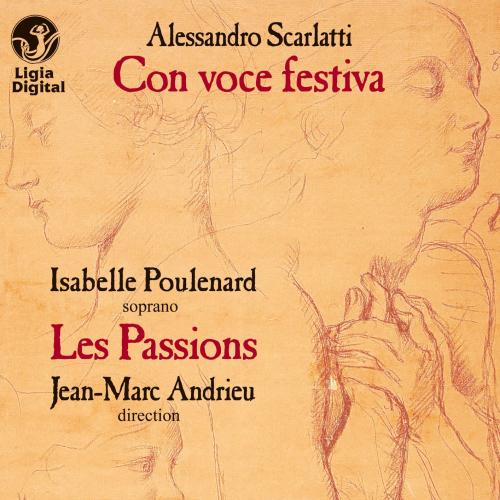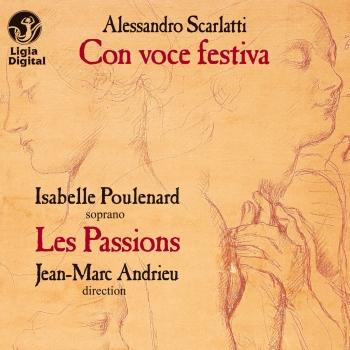
Scarlatti: Con voce festiva (Cantate e concerti) Isabelle Poulenard, Les Passions & Jean-Marc Andrieu
Album info
Album-Release:
2006
HRA-Release:
16.11.2018
Label: Ligia
Genre: Classical
Subgenre: Vocal
Artist: Isabelle Poulenard, Les Passions & Jean-Marc Andrieu
Composer: Alessandro Scarlatti (1660-1725)
Album including Album cover
- Alessandro Scarlatti (1660 - 1725): Con voce festiva. Aria con tromba sola:
- 1 Con voce festiva. Aria con tromba sola 01:30
- Il giardino d'Amore. Sinfonia de la sérénade pour trompette et cordes:
- 2 Il giardino d'Amore. Sinfonia de la sérénade pour trompette et cordes: I. Allegro 02:20
- 3 Il giardino d'Amore. Sinfonia de la sérénade pour trompette et cordes: II. Largo e piano 01:03
- 4 Il giardino d'Amore. Sinfonia de la sérénade pour trompette et cordes: III. Allegro 01:26
- La Fenice. Cantate pour soprano, 2 violons et basse continue:
- 5 La Fenice. Cantate pour soprano, 2 violons et basse continue: Introduzione 00:59
- 6 La Fenice. Cantate pour soprano, 2 violons et basse continue: Recitativo "Sù l'hora appunto che col'caro d'Oro" 00:54
- 7 La Fenice. Cantate pour soprano, 2 violons et basse continue: Aria "Se disciolti son quei nodi che rendevan" 01:23
- 8 La Fenice. Cantate pour soprano, 2 violons et basse continue: Recitativo "Gradita libertà quanto sei cara" 00:22
- 9 La Fenice. Cantate pour soprano, 2 violons et basse continue: Aria "Ogn' or cantando passare il giorno" 03:11
- 10 La Fenice. Cantate pour soprano, 2 violons et basse continue: Recitativo "Oh quanto più gioisce all'or ch'esposto" 01:05
- 11 La Fenice. Cantate pour soprano, 2 violons et basse continue: Aria "Che tal volta cupido tiranno" 02:07
- 12 La Fenice. Cantate pour soprano, 2 violons et basse continue: Recitativo "O come piu felice trà le selve d'Arabia" 00:52
- 13 La Fenice. Cantate pour soprano, 2 violons et basse continue: Dunque mio cor 01:47
- 14 La Fenice. Cantate pour soprano, 2 violons et basse continue: Arioso "Al ciel d'oncle discese" 00:42
- Mio tesoro. Aria, in forma di Menuet alla Francese:
- 15 Mio tesoro. Aria, in forma di Menuet alla Francese 03:35
- Concerto en La Mineur pour flûte à bec, 2 violons et b.c.:
- 16 Concerto en La Mineur pour flûte à bec, 2 violons et b.c.: I. Allegro 01:49
- 17 Concerto en La Mineur pour flûte à bec, 2 violons et b.c.: II. Largo 01:43
- 18 Concerto en La Mineur pour flûte à bec, 2 violons et b.c.: III. Fuga 02:14
- 19 Concerto en La Mineur pour flûte à bec, 2 violons et b.c.: IV. Piano 01:57
- 20 Concerto en La Mineur pour flûte à bec, 2 violons et b.c.: V. Allegro 01:48
- Su le sponde del Tebro. Cantate pour soprano, trompette, 2 violons et b.c.:
- 21 Su le sponde del Tebro. Cantate pour soprano, trompette, 2 violons et b.c.: Sinfonia, grave 01:48
- 22 Su le sponde del Tebro. Cantate pour soprano, trompette, 2 violons et b.c.: Recitativo "Su le sponde del Tebro" 00:50
- 23 Su le sponde del Tebro. Cantate pour soprano, trompette, 2 violons et b.c.: Rittornello e aria "Contentatevi o fidi pensieri" 02:38
- 24 Su le sponde del Tebro. Cantate pour soprano, trompette, 2 violons et b.c.: Recitativo e arioso "Mesto stanco... Infelici miei lumi" 04:33
- 25 Su le sponde del Tebro. Cantate pour soprano, trompette, 2 violons et b.c.: Aria e ritornello "Dite almeno, astri crudeli" 01:41
- 26 Su le sponde del Tebro. Cantate pour soprano, trompette, 2 violons et b.c.: Recitativo e aria "All'aura, all cielo... Tra lascia pur di piangere" 02:15
- Sonata 3e a 4, senza cembalo al tavolino:
- 27 Sonata 3e a 4, senza cembalo al tavolino: I. Sinfonia 02:11
- 28 Sonata 3e a 4, senza cembalo al tavolino: II. Grave 01:38
- 29 Sonata 3e a 4, senza cembalo al tavolino: III. Allegro 02:09
- 30 Sonata 3e a 4, senza cembalo al tavolino: IV. Minuet 01:19
- Clori mia, Clori bella. Cantate pour soprano, flûte à bec et b.c.:
- 31 Clori mia, Clori bella. Cantate pour soprano, flûte à bec et b.c.: Recitativo "Clori mia, Clori bella, ah, non più mia" 01:01
- 32 Clori mia, Clori bella. Cantate pour soprano, flûte à bec et b.c.: Aria, Adagio "Onde chiare che spargete" 04:55
- 33 Clori mia, Clori bella. Cantate pour soprano, flûte à bec et b.c.: Recitativo "Si, si narrate gli pur bell'onde" 00:50
- 34 Clori mia, Clori bella. Cantate pour soprano, flûte à bec et b.c.: Aria "Parla, parla il cor" 02:35
- 35 Abattaglia. Aria pour soprano, trompette, 2 violons et b.c.: I. Sinfonia, grave, allegretto 01:27
- 36 Abattaglia. Aria pour soprano, trompette, 2 violons et b.c.: II. Aria, allegro "A battaglia, pensieri battaglia" 02:10
Info for Scarlatti: Con voce festiva (Cantate e concerti)
During the course of his long life, Alessandro Scarlatti was not only a prolific composer of opera, he wrote more than 700 cantatas, many of which consisted of miniature scenes and often incorporated solo instruments to set off the voice. These works demonstrate the utility of the Neapolitan/Roman cantata for smaller chamber venues, and the composer was certainly much in demand for his expressive music of a more intimate sort. That being said, this group incorporates several pieces with a trumpet, so one supposes that the concept of “intimacy” must have been quite flexible, given its often high tessitura and virtuoso line. This disc contains a selection of pieces that could have been used in the various venues in Rome he haunted during the period around 1700, and thus it is a sort of grouping that works well. ...
"As for the performances themselves, I’ll confess to having mixed feelings. Andrieu’s recorder playing is superb, with a full, rounded tone and nice phrasing. He also blends much better with Poulenard in their duo cantata, in particular the delicate “Onde ciare che spargete.” His tempo for the fugue of the concerto in the third movement is rollicking, giving the counterpoint additional interest in the way he weaves in and out of the violin parts. On the other hand, Poulenard’s soprano is variable. In La Fenice , she floats with subtle ornamentation and clear voice in the second aria pastoral “Ogn’or cantando passare il giorno,” indicating that she is fully aware of the demands of Baroque singing style. On the other hand, in much of the rest she sings with lots of vibrato. This is most apparent in those arias that include the trumpet, as if she is afraid that a straight tone might be lost. The result is a sound that is often far too modern and operatic for the delicacy of the pieces, and she doesn’t blend well with the clarion sounds of the trumpet. Tizac’s playing also tends to be technically adept but sometimes without too much finesse. Finally, the recording venue seems to have produced an annoying reverberation that makes it seem like certain numbers were recorded in an echo chamber. The less said about the accompanying notes, the better; these lack any sort of real context for the works on the recording and are difficult to follow. Can one really be interested in “micro-modifications” of formal structure, not to mention the really awkward translation into English? (My favorite howler: “From a musical point of view, cantatas are of variable geometric genre.” Say what?) Moreover, the texts are translated into French only. Still, if one is able to put up with these annoyances, some of which are petty, then one will find some interesting and unusual music by one of the period’s greatest composers." (FANFARE, Bertil van Boer)
Isabelle Poulenard, soprano
Serge Tizac, trumpet
Les Passions
Jean-Marc Andrieu, conductor, flute
No biography found.
This album contains no booklet.











